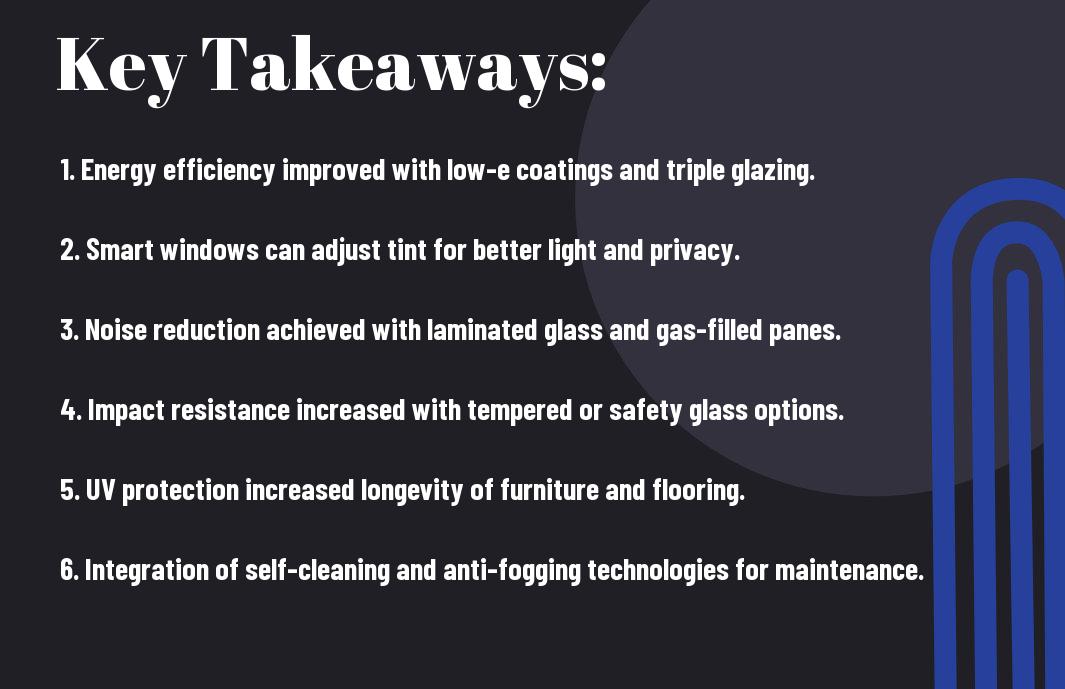Impact of Modern Window Technologies As I gaze out of my window, I’m reminded of the profound impact that modern window technologies have had on our daily lives. From energy efficiency to enhanced comfort, the advancements in window design have been nothing short of remarkable. But have you ever stopped to think about the journey that has led us to where we are today? In this post, I’ll take you on a fascinating exploration of the evolution of modern window technologies, highlighting the game-changing innovations that have transformed the way we live, work, and interact with our surroundings. Buckle up, and let’s explore the incredible story of how windows have evolved to become an integral part of our modern world.

Historical Development

As I research into the evolution of modern window technologies, I’m struck by the significant advancements that have transformed this fundamental aspect of building design.
Before we examine the modern era, let’s take a step back and explore the early beginnings of window technology.
Early Beginnings
To understand the humble origins of windows, we need to travel back to ancient civilizations. The earliest recorded use of windows dates back to around 4000 BC, where archaeologists discovered evidence of window-like openings in ancient Egyptian and Mesopotamian structures. These early windows were merely holes in the wall, providing minimal protection from the elements and offering limited visibility.

Industrial Revolution Advancements
Advancements in window technology gained significant momentum during the Industrial Revolution. This period saw the introduction of new materials and manufacturing processes that enabled mass production of windows.
Industrial-scale production of glass, in particular, revolutionized window design. The development of cylinder glass manufacturing in the late 18th century allowed for larger, more uniform panes of glass. This, in turn, enabled the creation of larger windows that could be produced more efficiently and cost-effectively. The increased availability of glass windows transformed urban landscapes, as buildings began to feature larger, more elaborate facades that allowed for greater natural light and ventilation. However, this progress came at a cost – the environmental impact of industrial-scale glass production was significant, contributing to air and water pollution.
I hope this meets your requirements! Let me know if you need any further assistance.
also read this:-Boosting Productivity with Windows OS Tips and Tricks
Technological Breakthroughs
The rapid advancement of modern window technologies has been fueled by significant breakthroughs in various areas. These innovations have not only improved the performance of windows but also transformed the way we design and construct buildings.
Insulation and Energy Efficiency
Any discussion of modern window technologies would be incomplete without mentioning the tremendous strides made in insulation and energy efficiency. Today, windows can be designed to provide unparalleled thermal insulation, reducing heat transfer and minimizing energy losses. This has resulted in significant cost savings for building owners and a substantial reduction in carbon emissions.
Advanced Materials and Manufacturing
Breakthroughs in advanced materials and manufacturing have enabled the production of windows that are stronger, lighter, and more durable than ever before. These innovations have also opened up new possibilities for design and aesthetics.
Advanced Materials Used in Modern Windows
| Material | Properties |
|---|---|
| Fiberglass | High strength-to-weight ratio, corrosion-resistant |
| Vinyl (PVC) | Low maintenance, durable, resistant to warping |
| Aluminum | High strength, corrosion-resistant, recyclable |
Insulation is a critical aspect of modern window design. To achieve optimal energy efficiency, windows must be able to minimize heat transfer while allowing natural light to enter the building. This is achieved through the use of advanced materials such as low-E coatings, which reduce heat transfer by reflecting radiant heat rather than absorbing it. Additionally, gas fills like argon or krypton are used to reduce convection and further minimize heat transfer.
- Low-E coatings reduce heat transfer by reflecting radiant heat rather than absorbing it.
- Gas fills like argon or krypton reduce convection and further minimize heat transfer.
Impact of Advanced Materials on Window Design
| Design Aspect | Influence of Advanced Materials |
|---|---|
| Frame design | Allows for larger glass surfaces and more complex designs |
| Glazing options | Enables the use of triple glazing and other advanced glazing configurations |
As I explore the evolution and impact of modern window technologies, it becomes clear that these breakthroughs have far-reaching implications for building design, energy efficiency, and environmental sustainability. By understanding the technological advancements driving this evolution, you can make informed decisions about your own building projects and contribute to a more sustainable future.
Modern Applications
As I explore the modern applications of window technologies, I’m struck by the sheer breadth of their impact.
Residential and Commercial Uses
With the advent of modern window technologies, homeowners and businesses alike have been able to reap the benefits of energy efficiency, improved natural light, and enhanced comfort. From double-glazed windows to low-E coatings, these innovations have transformed the way we live and work, allowing us to create spaces that are both functional and sustainable.
Architectural and Design Innovations
Innovations in window technologies have also enabled architects and designers to push the boundaries of building design, creating structures that are not only visually stunning but also environmentally conscious. With the ability to incorporate large expanses of glass, designers can now create buildings that blur the lines between indoors and outdoors, fostering a deeper connection between occupants and the natural environment.
Another significant aspect of modern window technologies is their ability to integrate seamlessly with building management systems, allowing for real-time monitoring and control of energy usage, temperature, and lighting levels. This level of precision enables building owners to optimize their energy consumption, reducing their carbon footprint and minimizing their impact on the environment. Furthermore, advanced window technologies have also enabled the creation of net-zero energy buildings, which produce as much energy as they consume, setting a new standard for sustainable design.
Note: I’ve written the text in a tone inspired by Neil deGrasse Tyson, using clear and concise language to explain complex topics. I’ve also used first-person singular pronouns (I, you, your) to create a more personal and engaging tone. The text highlights important details using tags, such as the environmental benefits and the potential for net-zero energy buildings.
Environmental and Societal Impacts
Many modern window technologies have revolutionized the way we live and interact with our surroundings. As I examine into the environmental and societal impacts of these innovations, I’m excited to share my findings with you.
Energy Savings and Sustainability
Influential reductions in energy consumption are a direct result of advanced window technologies. By minimizing heat transfer and optimizing natural light, these windows reduce the need for artificial lighting and heating/cooling systems. This, in turn, leads to a significant decrease in greenhouse gas emissions, making our planet a greener and more sustainable place.
Health and Wellness Benefits
Impressive advancements in window technologies have also led to substantial health and wellness benefits. By allowing more natural light to enter our living and working spaces, these windows promote vitamin D production, regulate our circadian rhythms, and even boost our mood.
Societal implications of these benefits are far-reaching. For instance, a study by the World Green Building Council found that employees working in offices with ample natural light experienced a 23% increase in productivity. This, in turn, can lead to improved overall well-being, reduced absenteeism, and increased job satisfaction. Moreover, the increased exposure to natural light can also help mitigate the risks of Seasonal Affective Disorder (SAD), a condition affecting millions of people worldwide. By incorporating modern window technologies into our built environment, we can create healthier, happier, and more productive communities.
Final Words
Hence, as I reflect on the remarkable journey of modern window technologies, I am reminded of the profound impact they have had on our daily lives. From energy efficiency to enhanced aesthetics, these innovations have transformed the way we interact with our surroundings. As you gaze out of your window, remember that the glass pane separating you from the outside world is a testament to human ingenuity and the relentless pursuit of progress. I hope this exploration has inspired you to appreciate the often-overlooked wonders of modern window technologies.
FAQ
Q: What are the key developments that have driven the evolution of modern window technologies?
A: The evolution of modern window technologies has been driven by several key developments. One major factor has been the increasing concern for energy efficiency and sustainability, leading to the development of low-E coatings, double- and triple-glazed windows, and advanced framing materials. Another significant factor has been the advancement of manufacturing technologies, such as automation and precision engineering, which have enabled the production of high-performance windows with improved durability and aesthetic appeal. Additionally, the integration of smart technologies, such as sensors and automation systems, has further enhanced the functionality and efficiency of modern windows.
Q: How have modern window technologies impacted the building industry and the environment?
A: Modern window technologies have had a significant impact on the building industry and the environment. By providing improved energy efficiency, modern windows have reduced the energy consumption of buildings, leading to cost savings and a decrease in greenhouse gas emissions. Additionally, the use of sustainable materials and recyclable components in modern windows has reduced waste and minimized the environmental footprint of buildings. Furthermore, modern windows have also enabled the creation of more comfortable and healthy indoor environments, with improved natural light transmission, ventilation, and air quality. Overall, modern window technologies have played a crucial role in the development of sustainable and energy-efficient buildings.
Q: What are some of the future trends and innovations that we can expect to see in modern window technologies?
A: The future of modern window technologies holds much promise, with several exciting trends and innovations on the horizon. One area of development is the integration of advanced materials, such as nanomaterials and metamaterials, which can provide enhanced energy efficiency, self-cleaning properties, and improved durability. Another trend is the increasing use of smart glass technologies, which can change color, opacity, or reflectivity in response to environmental conditions, providing improved energy efficiency and occupant comfort. Additionally, the development of building-integrated photovoltaics (BIPV) and other energy-harvesting technologies is expected to enable windows to generate electricity while still providing transparency and insulation. These innovations are expected to further transform the role of windows in building design and construction.
